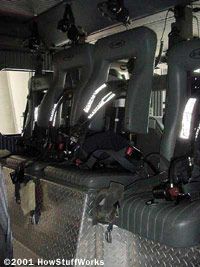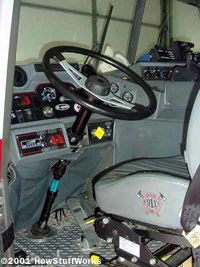Grab a Seat
The unique design of a fire engine allows it to carry a lot of crew to the fire scene. Up to eight firefighters, including the driver and the captain, can fit onto this E-One fire engine. The cabin of the fire engine is divided into two sections: the front seat, where the driver and captain sit, and the jumpseat area, where the firefighters sit.

As mentioned before, the driver is responsible for controlling the pump panel. For this reason, there are some basic controls on the driver's dashboard that are related to that task. Two red switches near his left hand operate a generator and jet dump. A jet dump essentially discharges all of the water in the tank into a drop tank through a large discharge outlet in the back.
Advertisement
The driver has another switch within reach that activates the automatic tire chains, which are sometimes needed during the winter to drive through ice and snow. Automatic tire chains save the time and hassle of jacking the truck up and putting tire chains on manually. Click here to learn more about automatic tire chains.
The captain sits in the passenger seat next to the driver in the front section of the cab. The front section of the cab has a firecom, which are radio headsets that allow the captain and driver to communicate with the firefighters sitting in the jumpseat area. The captain will often give instructions to the firefighters on the way to the fire scene.
The jumpseat area is like the backseat of your car. This is the area where four to six firefighters sit on the way to the fire. There is one row of four seats that sit back-to-back with the captain and driver. There are also two fold-down seats directly across from the row of four seats. In between the fold-down seats, there several yellow pouches that contain the firefighters' masks.
Air packs are located in the back of the four main seats. By already having the air packs on the truck, all the firefighters have to do is put them on their shoulders. Each air pack has 30 minutes of air.
For more information on fire engines, firefighters and related topics, check out the links below.
Related HowStuffWorks Articles
- How Fire Works
- How Wildfires Work
- How Smoke Detectors Work
- How Water Towers Work
- How the 'Jaws of Life' Work
- How do smoke detectors intercommunicate?
- Why does smoke come from a fire?
- How do multi-class dry chemical fire extinguishers work?
- What do the big diamond-shaped signs with red, yellow and blue diamonds mean?
More Great Links
- Fire Engine Tour City of Davis, CA Fire Department
- American LaFrance (manufacturer)
- E-One (manufacturer)
- Pierce Manufacturing
- National Fire and Rescue Magazine
- Boulder Rural Fire Department (includes photos)
- National Fire Protection Association
- FireHydrant.org
